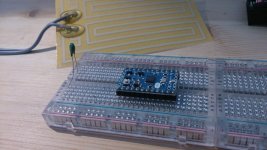Hello.
E-Biking in Norway during winter season can be a challenge with ebike batteries. On my bike I am not going to have a easily removable pack this winter. So I am considering to build a semi-automated system using a arduino mini into the pack enclosure.
Using a aluminum enclosure 146x222x55mm, I have figured that I can theoreticly fit 20pc 5000mAh 20C Turnigy cells, 10S2P for a 370Wh configuration. That leaves just enough space for heat insulation and electronics like BMS, Volt-display, connectors, main circuit braker, DC-DC converter, arduino and heater mat.
I am thinking of having a pre-drive heating function that takes the temp in the middle of the pack from a thermistor and warms it to desired temp automaticly when switched on, using a heat mat underneath the cells, cutting when desired temp is accomplished.
Mathematicly it seems for me to be worth while, even considdering the powerloss that heating will take from the pack....
Does anybody have any experience with this kind of a setup? Dangers, drawbacks, and so on?
E-Biking in Norway during winter season can be a challenge with ebike batteries. On my bike I am not going to have a easily removable pack this winter. So I am considering to build a semi-automated system using a arduino mini into the pack enclosure.
Using a aluminum enclosure 146x222x55mm, I have figured that I can theoreticly fit 20pc 5000mAh 20C Turnigy cells, 10S2P for a 370Wh configuration. That leaves just enough space for heat insulation and electronics like BMS, Volt-display, connectors, main circuit braker, DC-DC converter, arduino and heater mat.
I am thinking of having a pre-drive heating function that takes the temp in the middle of the pack from a thermistor and warms it to desired temp automaticly when switched on, using a heat mat underneath the cells, cutting when desired temp is accomplished.
Mathematicly it seems for me to be worth while, even considdering the powerloss that heating will take from the pack....
Does anybody have any experience with this kind of a setup? Dangers, drawbacks, and so on?


